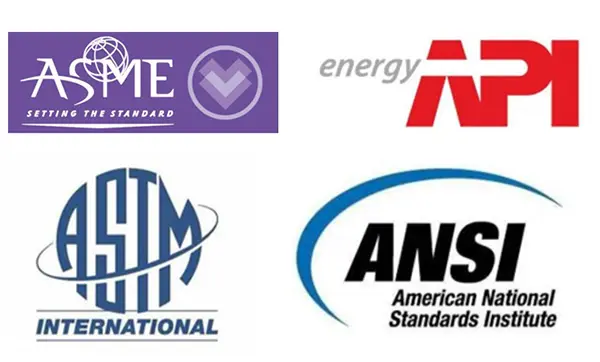In industrial settings, maintaining safety, efficiency, and reliability is critical. Two key organizations that provide essential guidelines to achieve these goals are the American National Standards Institute (ANSI) and the American Society of Mechanical Engineers (ASME). These standards ensure product quality, compatibility, and safety across various industries, from manufacturing and construction to energy and transportation.
This article explores the roles of ANSI and ASME, highlighting their differences and the importance of their standards in industrial applications.
What Is ANSI?
The American National Standards Institute (ANSI) is a non-profit organization that oversees and accredits standards developed by other organizations. ANSI plays a key role in ensuring that U.S. standards are aligned with international guidelines, promoting fair practices and product compatibility worldwide.
Primary Focus of ANSI:
- Accrediting and coordinating standards from multiple industries
- Aligning U.S. standards with international standards, such as ISO and IEC
- Covering a wide range of industries, including safety equipment, consumer goods, and electrical systems
Examples of ANSI Standards:
- ANSI Z87.1: Standard for eye protection in industrial settings
- ANSI B16.5: Standard for pipe flanges and flanged fittings
- ANSI C136: Standard for roadway and area lighting
What Is ASME?
The American Society of Mechanical Engineers (ASME) is a professional organization known for developing technical standards for mechanical systems and components. ASME standards are widely used in the manufacturing, energy, and construction sectors to ensure the safety and reliability of mechanical systems.
Primary Focus of ASME:
- Developing technical standards for pressure vessels, piping, boilers, and mechanical components
- Ensuring safety, performance, and reliability of equipment
- Providing certifications and training for industry professionals
Examples of ASME Standards:
- ASME BPVC (Boiler and Pressure Vessel Code): Essential for pressure vessels and boilers
- ASME B31.1: Standard for power piping systems
- ASME Y14.5: Standard for dimensioning and tolerancing in engineering drawings
Key Differences Between ANSI and ASME
| Aspect | ANSI | ASME |
|---|---|---|
| Full Name | American National Standards Institute | American Society of Mechanical Engineers |
| Function | Oversees and accredits standards | Develops technical standards for mechanical systems |
| Focus | Ensures consistency and fairness in standardization | Safety and performance standards for mechanical equipment |
| Industry Scope | Multiple industries, including safety, electrical, and consumer goods | Focus on mechanical engineering, pressure vessels, piping, and boilers |
| Global Alignment | Aligns U.S. standards with international standards | Recognized internationally, especially in mechanical and energy industries |
Importance of ANSI and ASME Standards in Industrial Applications
1. Ensuring Safety and Reliability
Both ANSI and ASME standards are critical for ensuring that products and systems meet stringent safety requirements. For example, ASME’s Boiler and Pressure Vessel Code reduces the risk of catastrophic failures in industrial operations.
2. Enhancing Product Quality
Adherence to ANSI and ASME standards ensures that industrial products and systems meet high-quality benchmarks. This improves performance, durability, and compatibility with other equipment.
3. Supporting International Trade
ANSI’s role in aligning U.S. standards with international standards (ISO and IEC) facilitates global trade, allowing U.S. manufacturers to compete in international markets. ASME standards are also recognized worldwide, particularly in industries such as oil and gas.
4. Compliance with Regulations
Many government regulations and industry requirements reference ANSI and ASME standards. Compliance ensures that businesses avoid penalties and remain in good standing with regulatory bodies.
Examples of ANSI and ASME Standards in Action
- Industrial Piping Systems: ASME B31.3 Process Piping standard is critical for ensuring the safe design and operation of piping in chemical and petroleum plants.
- Eye Protection Equipment: ANSI Z87.1 Standard defines safety requirements for protective eyewear in industrial environments.
- Boiler Systems: ASME BPVC ensures that pressure vessels and boilers meet rigorous safety and performance standards.
How to Choose the Right Standards for Your Application
- Identify the industry requirements: Determine which standards apply to your specific industry and operations.
- Consult with professionals: Engage with engineers, safety officers, or consultants to ensure compliance.
- Stay updated: Standards are regularly revised. Keep track of updates from ANSI and ASME to maintain compliance and improve operations.
Conclusion
Both ANSI and ASME standards are vital for maintaining safety, quality, and performance in industrial applications. While ANSI focuses on accrediting and harmonizing standards across industries, ASME specializes in developing technical guidelines for mechanical systems. Understanding and implementing these standards will help businesses achieve regulatory compliance, improve product reliability, and enhance operational safety.
Whether you’re in manufacturing, energy, or construction, adhering to ANSI and ASME standards is essential for success and sustainability.







